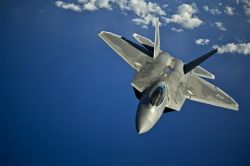LANGLEY AIR FORCE BASE, Va., May 5, 2012 — The commander of the Air Force’s Air Combat Command met with reporters this week to discuss the national security imperative for the F‑22 Raptor fighter jet, the status of efforts to identify a root cause for unexplained physiological incidents with the aircraft, and risk mitigation efforts since the Raptor’s return to flying operations in September 2011.
Confirming recent media reports of the F‑22 deploying to Southwest Asia, Air Force Gen. Mike Hostage emphasized the Raptor’s ability to support combatant commander requirements around the world.
“I won’t comment where it’s deployed to or where it deployed from, but yes, the F‑22 is on an operational deployment now. And this is not the first operational deployment,” he said. “If your adversary is so concerned about what your capabilities are they decide not to engage with you, that, to me, is the ultimate use of your military capability. People pay attention to where this airplane goes and what it does. … We need to make sure that it’s a sustained part of our inventory.”
A command-directed F‑22 stand-down from May to September 2011 was a prudent measure following reports of potential oxygen system malfunctions, the general said. Since the stand-down, he added, Air Combat Command has implemented risk mitigation measures intended to protect F‑22 pilots and maintenance crews and prevent future incidents.
Though he understands there are still concerns about the aircraft, Hostage said, a certain amount of risk always is involved and must be balanced with the requirement for the capability.
“In a peacetime training circumstance, we want to operate at as low of risk is prudent for the level of training we get out of a mission,” he explained. “When we go into combat, risk goes up, but the reason to assume that risk goes up as well.
“We live in a community where risk is part of our lives,” he continued. “If we think the risk has gone to a level where we just can’t accept it, we either reduce that risk or eliminate it. But right now, we believe that risk — although it’s not as low as we would like it — is low enough to safely operate the airplane at the current tempo.”
Hostage said he doesn’t expect his airmen to take the risk alone. In an effort to learn more about the aircraft and get a better understanding of what F‑22 pilots are dealing with, he said, hesoon will begin flying the Raptor himself.
“I’m asking these guys to assume some risk that’s over and above what everybody else is assuming, and I don’t feel like it’s right that I ask them to do it and then I’m not willing to do it myself — that’s not fair,” he said. The day officials figure out the problem is the day he will stop flying, he added.
Since the aircraft resumed flying operations in September, the F‑22 has flown more than 12,000 sorties and returned to operational capability.
“We’ve taken a very specific, methodical approach to how we return to flying — the types of missions and the durations of the missions,” said Air Force Maj. Gen. Charles W. Lyon, Air Combat Command’s director of operations, who also participated in the media roundtable. “We’ve been continually increasing the types and durations.”
The Air Force continues to search for the root cause of the unexplained physiological incidents using detailed data-collection methods, which will soon include centrifuge and high-energy testing. Hostage said he believes the command is making significant progress toward an answer, but he emphasized that scientific testing and data collection take time.
“I believe we are making significant progress toward an answer,” Hostage said. “I don’t want to characterize how far or when, because I don’t own the progress of science. But I am confident we’re going to get to a solution.”
Both Lyon and Hostage compared this to the early days of the F‑16 Fighting Falcon. Although the first F‑16 had its first operational flight in 1970, the combat edge aircrew flight equipment, which was optimized for high‑G flight, wasn’t fielded until about 1988, Lyon said.
“We didn’t field it slowly because we had fiscal challenges,” he said. “It took us that long to get the understanding over time of what was actually happening.”
Hostage said a similar situation exists with the F‑22 regarding the unknown effects of human physiology and technology.
“What we’re looking at is human physiology and the regime this airplane operates in,” he said. “This airplane does things airplanes have never done before in regimes of flight that we’ve never operated in before.”
Hostage said he’s confident a solution for what he calls “the most tactically-capable aircraft in the world” will come.
“This nation needs this airplane and every one of them,” he said. “I wish I had 10 times as many as I have.”
Source:
U.S. Department of Defense
Office of the Assistant Secretary of Defense (Public Affairs)

 von
von 
